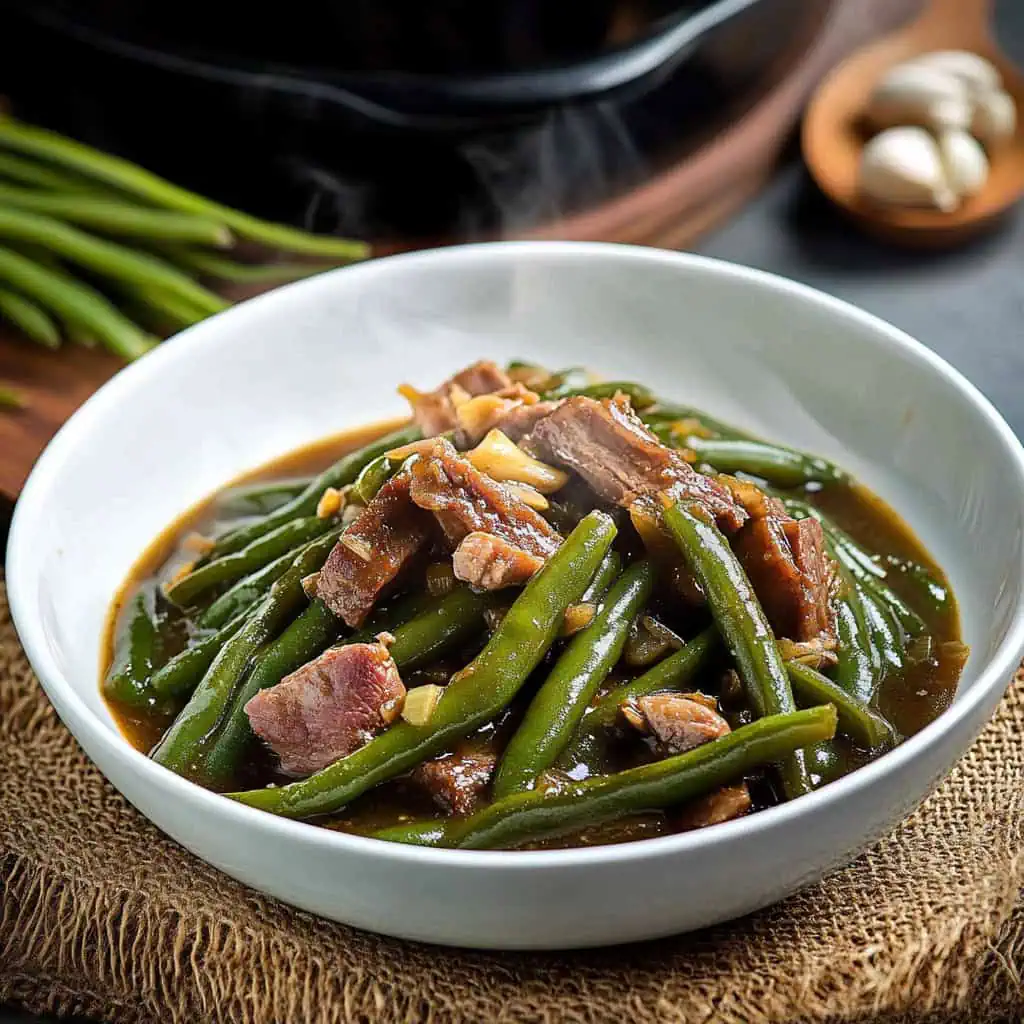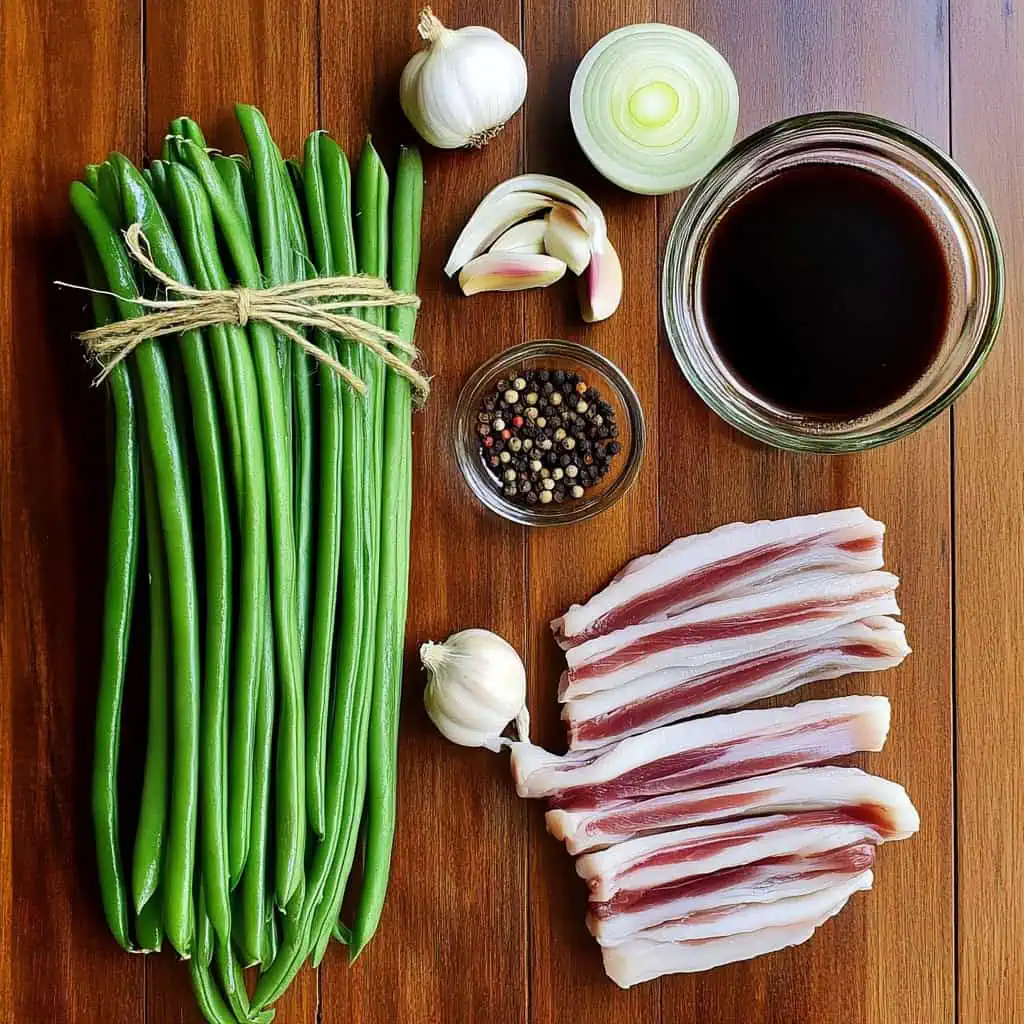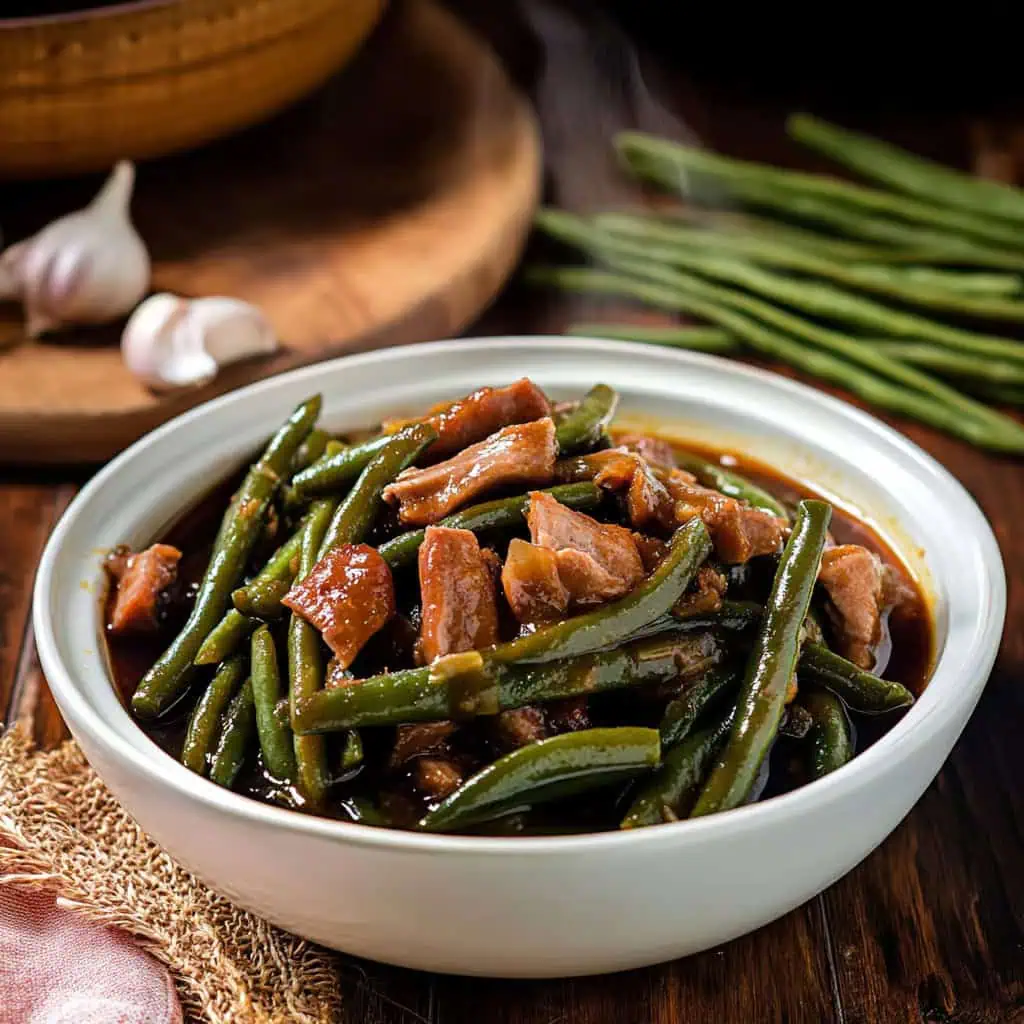Growing up in our humble home in Bataan, our backyard was a treasure trove of fresh vegetables, including the ever-reliable sitaw that would climb up our bamboo trellises.
Every morning, my Lola would send me to pick the long, slender beans, their tips reaching toward the sky like green fingers.
This Adobong Sitaw recipe brings back those cherished memories, transforming these simple string beans into a mouthwatering dish using the same beloved adobo technique that makes Filipino cuisine so special.
What I love most about this Adobong Sitaw is how it turns an everyday vegetable into something delicious. The string beans soak up the perfect balance of soy sauce and vinegar, while staying delightfully crisp-tender.
Whether you choose to add pork belly for extra richness or keep it vegetarian, this 35-minute recipe proves that the magic of adobo isn't just for meat, it's a cooking style that makes even the humblest ingredients shine.'
Jump to:

Why You'll Love This Recipe
- Simple yet flavorful combination of tender-crisp vegetables and rich adobo sauce
- Versatile recipe that works beautifully as both vegetarian and meat versions
- Budget-friendly and nutritious
- Ready in under 45 minutes
- Perfect balance of salty, tangy, and umami flavors
- Great way to introduce vegetables to picky eaters
Ingredients
This recipe brings together the perfect balance of fresh and pantry staples. String beans provide a crisp, earthy base that absorbs flavors beautifully. Pork belly adds richness and umami (though optional), while garlic and onions create an aromatic foundation.
The key to adobo's signature taste is the perfect ratio of soy sauce (for saltiness) to vinegar (for tanginess), balanced with water to create a savory sauce that transforms simple ingredients into an unforgettable dish.

- 1 lb string beans (sitaw), cut into 2-inch lengths
- ¼ lb pork belly (liempo), thinly sliced (optional)
- 1 medium onion, thinly sliced lengthwise
- 4-6 cloves garlic, crushed
- ½ teaspoon ground black pepper
- ½ cup soy sauce
- ⅓ cup vinegar
- 1 cup water
Equipment
- Large wok or deep skillet (kawali) - For even cooking and sufficient space to toss ingredients
- Sharp knife - For cutting string beans and meat with precision
- Cutting board - For safe and clean food preparation
- Measuring cups and spoons - For precise seasoning and consistent results
- Tongs - For easy stirring and serving without breaking the beans
- Heavy lid - For proper simmering and flavor development

How To Make
- First, slice your pork belly into thin strips, crush the garlic cloves, and cut the onion into thin slices. Cut your string beans into 2-inch lengths.
- Heat your pan over medium-high heat. Add the pork belly slices and cook until they start to brown and release their oil. This will take about 3-4 minutes.
- Once you see oil from the pork, add your crushed garlic and sliced onions. Cook these together with the pork for 2 minutes, stirring occasionally until the onions become clear and soft.
- Pour in the soy sauce, vinegar, and water. Let it come to a boil without stirring. Once it starts bubbling, add your ground black pepper and stir everything together.
- Cover the pan and lower the heat to medium-low. Let it simmer for 15 minutes or until your pork becomes tender. Check occasionally and give it a gentle stir.
- Add your cut string beans to the pan. Stir them gently to coat with the sauce. Cook for 3-5 minutes until the beans are just tender but still have a slight crunch. Be careful not to overcook them – you want them to stay bright green and slightly crisp.
- Turn off the heat and transfer everything to a serving bowl. The sauce should be rich and dark, coating each piece of string bean and pork.
- Let it rest for 2-3 minutes before serving. This tastes best when served hot with freshly cooked white rice.
- For a vegetarian version, simply skip the pork and start by sautéing the garlic and onions in 2 tablespoons of cooking oil instead.

Tips from Lola's Kitchen
- Don't rush the browning process - Allowing the pork to properly brown creates the foundation of flavor for the entire dish
- Let the vinegar boil before stirring - This eliminates the raw vinegar taste and creates a smooth, balanced sauce
- Cut string beans at an angle - This not only looks more appealing but helps the beans absorb more flavor
- Season gradually and taste as you go - Every batch of beans and every brand of soy sauce is different, so adjust to your preference
- Keep the beans crisp - Overcooked beans lose their vibrant color and texture, so watch them carefully during the final cooking stage
- For extra depth, add 1-2 dried bay leaves - Remove before serving for a subtle aromatic note
- Let the dish rest before serving - This allows the flavors to meld together perfectly
Substitutions
- Pork belly: Substitute with chicken thigh fillets, ground pork, tofu cubes, or mushrooms for different protein options
- Soy sauce: Use coconut aminos or tamari for a gluten-free option
- White vinegar: Replace with apple cider vinegar, cane vinegar, or rice vinegar for different flavor profiles
- String beans: Use regular green beans, snow peas, or asparagus if long beans aren't available
- Onion: Substitute with shallots for a milder, sweeter flavor
- Fresh garlic: If unavailable, use 1 teaspoon of garlic powder, but add it with the liquids
Troubleshooting
- Too salty? Add a splash of water, a tablespoon of sugar, or ¼ cup coconut milk to balance the saltiness
- Too sour? Add a teaspoon of sugar or a tablespoon of honey to mellow the acidity
- Beans still too tough? Cook for additional 2-3 minutes, but watch carefully to prevent mushiness
- Sauce too thin? Remove the lid and simmer for 3-5 minutes to reduce and thicken
- Sauce too thick? Add 2-3 tablespoons of water or broth to reach desired consistency
- Pork not tender enough? Simmer for additional 5-10 minutes before adding the beans
Storage & Reheating
- Refrigeration: Store in an airtight container for up to 3 days. The flavors often deepen overnight!
- Freezing: Can be frozen for up to 1 month, though beans may become softer when thawed
- Reheating on stovetop: Place in a pan over medium-low heat with 1-2 tablespoons of water, stirring occasionally until heated through (about 5 minutes)
- Reheating in microwave: Cover with a damp paper towel and heat in 30-second intervals, stirring between each, until hot
- Freshening up leftovers: Add a squeeze of lime juice and fresh sliced green onions when reheating to brighten the flavors

FAQ
Can I make this completely vegetarian?
Absolutely! Skip the pork and use 2 tablespoons of vegetable oil or coconut oil for sautéing. For added protein, toss in firm tofu or tempeh cubes when you would normally add the pork.
How do I know when the string beans are perfectly cooked?
They should be bright green and slightly crisp when bitten—not mushy or stringy. Test one by cutting it with the side of your spoon; it should give some resistance but cut cleanly.
Can I make this in advance for a party?
Yes, but slightly undercook the beans if making ahead. Reheat gently and the beans will finish cooking without becoming mushy. It's best prepared fresh or just a few hours before serving.
Is this recipe keto-friendly?
Yes, string beans are low in carbs, and the pork adds healthy fats. You may want to reduce the soy sauce amount for sodium control and check for added sugars in your soy sauce.
How spicy is this dish traditionally?
The classic version isn't spicy at all, but many Filipino households add sliced bird's eye chilies (siling labuyo) according to taste. You can add them with the garlic and onions for a spicy kick.
Can I use frozen string beans instead of fresh?
Yes, though fresh provides better texture. If using frozen, don't thaw first, add them directly to the sauce but reduce cooking time by 1-2 minutes as they're partially cooked.
What's the secret to getting that perfect adobo flavor?
The key is the proper ratio of soy sauce to vinegar (generally 3:2) and allowing the sauce to reduce slightly while cooking. Also, letting the dish rest for a few minutes before serving helps the flavors meld.
What can I serve with Adobong Sitaw for a complete meal?
Steamed white rice is traditional, but it also pairs wonderfully with garlic fried rice. Add a side of fried fish, grilled chicken, or a simple egg drop soup to complete the meal.
Related
Looking for other recipes like this? Try these:

Adobong Sitaw (Filipino String Bean Adobo)
Equipment
- Large wok or deep skillet (kawali) For even cooking and sufficient space to toss ingredients
- Sharp knife (kutsilyo) For cutting string beans and meat
- Cutting board (Tabla) For preparation
- Measuring cups and spoons (Panukat) For precise seasoning
- Tongs [Sipit] For easy stirring and serving
- Heavy lid For simmering
Ingredients
Main Ingredients:
- 1 lb string beans sitaw - cut into 2-inch lengths
- ¼ lb pork belly liempo, thinly sliced (optional)
- 1 medium onion sibuyas, thinly sliced lengthwise
- 4-6 cloves garlic bawang, crushed
- ½ teaspoon ground black pepper paminta
Sauce:
- ½ cup soy sauce toyo
- ⅓ cup vinegar suka
- 1 cup water tubig
Instructions
- First, slice your pork belly into thin strips, crush the garlic cloves, and cut the onion into thin slices. Cut your string beans into 2-inch lengths.
- Heat your pan over medium-high heat. Add the pork belly slices and cook until they start to brown and release their oil. This will take about 3-4 minutes.
- Once you see oil from the pork, add your crushed garlic and sliced onions. Cook these together with the pork for 2 minutes, stirring occasionally until the onions become clear and soft.
- Pour in the soy sauce, vinegar, and water. Let it come to a boil without stirring. Once it starts bubbling, add your ground black pepper and stir everything together.
- Cover the pan and lower the heat to medium-low. Let it simmer for 15 minutes or until your pork becomes tender. Check occasionally and give it a gentle stir.
- Add your cut string beans to the pan. Stir them gently to coat with the sauce. Cook for 3-5 minutes until the beans are just tender but still have a slight crunch. Be careful not to overcook them – you want them to stay bright green and slightly crisp.
- Turn off the heat and transfer everything to a serving bowl. The sauce should be rich and dark, coating each piece of string bean and pork.
- Let it rest for 2-3 minutes before serving. This tastes best when served hot with freshly cooked white rice.
- For a vegetarian version, simply skip the pork and start by sautéing the garlic and onions in 2 tablespoons of cooking oil instead.
Tips from Lola's Kitchen
- Let the vinegar boil before stirring to eliminate the raw vinegar taste (lasa ng hilaw na suka)
- Don't overcrowd the pan to ensure even cooking
- Cut string beans at an angle for better presentation
- Season gradually and taste as you go (unting-unti at tikman)
- For extra flavor, add dried bay leaves (dahon ng laurel)
Nutrition
The Story Behind Adobong Sitaw (Filipino String Bean Adobo)
The roots of Adobong Sitaw lie in the ingenious Filipino tradition of applying our beloved adobo cooking method to virtually any ingredient. While the origins of adobo itself can be traced back to the Spanish colonial period, with its name derived from the Spanish word "adobar" meaning to marinate, our ancestors transformed this preservation technique into something uniquely Filipino by incorporating native ingredients and methods.
In Filipino households, particularly in rural areas and provinces, sitaw (string beans) has long been a backyard garden staple. These climbing vines, easily grown on bamboo trellises or along fences, provide a sustainable source of fresh vegetables throughout the year. Resourceful Filipino cooks, always finding ways to create delicious meals from available ingredients, naturally began applying the adobo technique to these abundant vegetables, creating what we now know as Adobong Sitaw.
The dish perfectly exemplifies the Filipino principle of "zero waste" cooking, especially in its variant that includes pork belly. The fatty meat not only adds flavor but also provides the oil needed for sautéing, while its proteins make the simple vegetable dish more filling and substantial. Many Filipino families who couldn't afford meat would prepare a purely vegetarian version, demonstrating how this recipe has historically adapted to different economic circumstances while maintaining its delicious essence.
Today, Adobong Sitaw continues to be a beloved dish that bridges generations. From simple carinderias to modern Filipino restaurants, this humble dish showcases how our cuisine can elevate simple vegetables into crave-worthy ulam. Its popularity has even grown among health-conscious diners and vegetarians looking to enjoy the classic adobo flavor profile in a lighter, vegetable-forward format. The dish represents the perfect marriage of traditional Filipino cooking techniques with practical, everyday ingredients – a true testament to the ingenuity and resourcefulness of Filipino home cooking.
In modern Filipino cuisine, Adobong Sitaw stands alongside other vegetable adobo variations like Adobong Kangkong (water spinach) and Adobong Talong (eggplant), forming a family of dishes that prove the versatility of the adobo cooking technique. Whether served in its traditional form or adapted for contemporary dietary preferences, this dish continues to be a brilliant example of how Filipino cooking transforms simple ingredients into something truly special.










Comments
No Comments